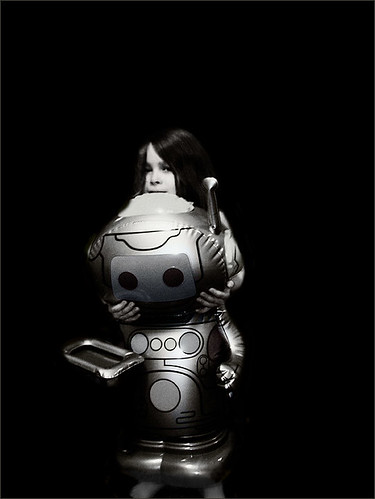Click on the image to view larger at Flickr.
Portrait of a boy and his robot
Digital photo with post production
Copyright J Kearns 2006
We had a children’s science museum down the street when we first moved to this building. H.o.p. loved going there despite the weariness of the exhibits, The weariness of the exhibits forecast the museum’s shutting down and when it did we bought for H.o.p. a robot he’d been eyeing in the museum gift shop. Well, the inflatable toy was called a “robot” but all that it does is have a remote control device that has two buttons that enable you to run the thing forward and backward, so it isn’t any more advanced than a remote-controlled toy car from the 50s and 60s. The difference is that it is called a “robot” and comes with a cute face and a humanoid body.
H.o.p., despite his desire to have a so-called robot, promptly hid the remote control device. He didn’t want the robot running around. He wanted to look at it.
Every so often the robot, set off by something outside, would tear off across the floor seemingly on its own power. Some times instead it would grind forward in short spurts. We would go to bed and get up to find the robot on the other side of the room and it was kind of fun and H.o.p. didn’t seem to mind this.
The so-called robot has a face. Whether the brain is programmed to look for human faces in things naturally, or if the brain begins to do this because of early nurture, I don’t know. But it’s something the brain does, it looks for faces. People see the face of Christ in grilled cheese sandwiches and the face of Elvis in door screens. They seek to apply meaning to what others may view as a random event.
It doesn’t take much to create a seemingly recognizable face for the brain. To confer humanity. Three markings is all it may require and sometimes even less. Two for the eyes and one for a mouth.

Leave a Reply